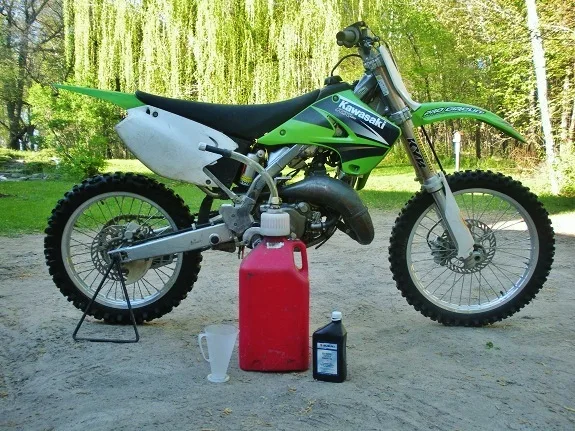Trying to decide if you should go with race fuel or pump gas in your dirt bike but can’t decipher what’s true and what’s not? There are a lot of people draining their bank account on fuel that’s completely unnecessary.
However, there is a time and place to use race fuel because it can do good things for your dirt bike. That’s why I’m going to answer the most common questions about race gas vs pump gas and how to know which is best for your dirt bike based on your specific needs.
Can you run race gas in your dirt bike?
Yep, you sure can… But it may not help. In fact, you may be doing more harm than good WHILE spending boatloads of your hard-earned money for nothing!
![VP 110 Racing Fuel Race Fuel or Pump Gas In Your Dirt Bike [Truth vs Lies]](https://motocrosshideout.com/wp-content/uploads/2023/12/VP-110-Racing-Fuel.jpg.webp)
Why is race gas bad to run in a dirt bike?
If you're running race gas through a dirt bike that doesn't need it or isn't tuned for it, you might run into these symptoms/problems:
- Poor throttle response
- Spark plug fouling
- Less power
What fuel is best for dirt bikes?
The best fuel for your specific dirt bike is what the manual recommends. For example, a Honda CRF250F trail bike is made to work well with regular 87-octane pump gas.
Do dirt bikes need premium gas?
Dirt bikes with “race engines”, such as the Yamaha YZ250F motocross bike, require 91-octane premium pump gas.
The main difference is that most motocross or high-performance enduro bike engines have higher compression and need a higher octane to prevent detonation.
What happens if you use regular 87 in a dirt bike that requires 91 premium gas?
You may or may not notice the effects right away, but if you use the wrong gas or too low of octane for your dirt bike, the fuel will burn too quickly and potentially cause:
- Overheating
- Detonation
- More rapid fuel consumption
- Backfiring
- Bogging
- The top-end to burn down (wear out much quicker)
Does elevation affect what fuel you should use?
Yes, as you go up in elevation, there is less oxygen in the air, which means that the compression of your engine is lower. For example, if your dirt bike engine has a 13.5:1 compression ratio at 1000 ft. elevation, when you ride at 5000 ft. elevation the compression ratio might be closer to 12.5:1.
I don’t have a calculator for this, but if you’re riding above 5000 feet elevation, you can generally run fuel with an octane rating that’s 2 full points lower than if you were riding closer to sea level (i.e. 91 down to 89)
![Colorado 2016 11 Race Fuel or Pump Gas In Your Dirt Bike [Truth vs Lies]](https://motocrosshideout.com/wp-content/uploads/2020/01/Colorado-2016-11-1024x576.jpg.webp)
Summer vs Winter pump gas
Another thing to keep in mind if you’re using pump gas is that it changes to a different blend in the winter (colder months) compared to the summer. The “winter blend” has extra additives that cause the fuel to break down quicker and “gum up” your carb/fuel system because it attracts more water.
What gas do pro motocross riders use?
Race fuels have changed a lot in the past 20 years because things were less complicated due to fewer regulations. VP110 leaded race fuel was common, but after doing some research, here’s what I found to be popular for pro motocross riders:
- VP Racing MR Pro6-HT Reg
- ETS Racing Fuels US MX 21 K2
- VP Racing MRX02 - 2 stroke
![VP Racing MR PR08 Race Fuel Race Fuel or Pump Gas In Your Dirt Bike [Truth vs Lies]](https://motocrosshideout.com/wp-content/uploads/2023/12/VP-Racing-MR-PR08-Race-Fuel.webp)
Does race gas make a difference? VP 110 vs 93 Pump gas
Race gas, such as VP110, can make a positive difference in your dirt bike if it’s set up for it, especially if you’re racing and demand the most performance out of your engine.
Race gas will make more of a difference in your dirt bike if you:
- Have a higher compression engine (13.5+:1 in race bikes or 11.0+:1 in air-cooled engines
- Tune the carb or EFI system specifically for the race gas you’re using
- Care about consistency in peak power and throttle response
Race gas will NOT make a difference if you:
- Have a stock dirt bike
- Upgraded the intake and/or exhaust and nothing else
- Don’t tune the fuel system for the race gas that you’re using
How much HP does 110 octane add?
If you’re just using 110 octane gas for the reason of adding more power, you’re probably not going to feel or see any horsepower increase on the dyno. This is because octane doesn’t affect the power in itself.
However, if the 110 fuel has other additives that burn more efficiently and you properly tune the carb or EFI for it, then you could realistically see anywhere from 0.5 HP to 2.0 HP increase in performance.
Can you run 100 octane in a dirt bike?
Yes, 100 octane can be used in a dirt bike, but it’s most likely not the best unless it’s tuned specifically for it. Take 100LL aviation gas (Avgas) for example - it’s an easy way to run higher octane fuel if your dirt bike has higher compression. It also lasts longer than pump gas, which means it can be stored for months without breaking down and making the fuel system dirty.
Also, avgas in particular has lead in it, which can cause more frequent plug fouling. It’s also not AMA-legal for competitive racing since they banned “leaded fuels”.
50/50 race gas & regular fuel - is mixing a BAD idea?
No, as long as you properly plan and use the mixed fuel - I’ve done it in one of my race bikes. If your dirt bike needs more than 91 octane but less than 100 octane, you can mix 91 premium and 110 race gas at a 50/50 equal mixture, this will give you a calculated 100.5 octane fuel mixture.
When is it bad to use mixed race and regular fuel?
One huge mistake that I made was using mixed race and pump gas that had been sitting for over a month. While race gas can last much longer, once it’s mixed, the fuel will break down faster.
What happened? It burned down the top end on my KX125 2-stroke and I had to get the cylinder replated because it was scored (scratches in the cylinder wall).

Can you run race gas in a stock motor?
Yes, but it’s probably not going to help because stock dirt bike engines don’t need higher-octane fuel. You only need race gas if you have higher compression or the fuel has power-increasing additives and you get your fuel system tuned specifically for that fuel.
Race gas in 2 stroke dirt bike - is it needed?
Most 2-stroke dirt bikes are made to be run on 91 premium pump gas or lower grades of fuel. The only way you'll need to use race gas in a 2 stroke is it the top-end is modified for more compression.
Why do people run race gas in stock dirt bikes?
Mainly because they think it’s cool or they believe a myth that race gas is always best but they’re throwing money away.
It’s sad, but true - if you’re running race gas in a stock dirt bike without proper tuning or changing anything else, then you’re just spending more money for a different exhaust smell and the same or potentially worse engine performance.
Pump gas - which is best?
In my experience, the best pump gas to use is one that’s rated for your engine and will last the longest before breaking down and causing fuel system issues.
Here are the most popular pump fuels in my area and how I rank them:
- 87 Regular: best cheap gas if you’re going to use it all within 1 month
- 91 Premium: best cheap 91-octane pump gas if you have a high-performance engine
- 91 Non-Oxy: longest lasting 91 premium pump gas
![91 Octane No Ethanol Added Premium Pump Gas Race Fuel or Pump Gas In Your Dirt Bike [Truth vs Lies]](https://motocrosshideout.com/wp-content/uploads/2023/12/91-Octane-No-Ethanol-Added-Premium-Pump-Gas-1200x859.jpg.webp)
Will race fuel clean a carburetor?
No fuel, pump gas or race gas, will clean a carburetor unless it has cleaning additives in it. Even then, if a dirt bike has been sitting for over 1 year, it will likely need a full & proper carb clean to get it started and running well again.
Does racing fuel clean your engine?
Just like most fuels won’t clean the carb or EFI system, they won’t clean your internal engine parts unless they have a proven additive specifically designed for it.
What makes an engine or carb get dirty?
- Sitting in storage - gas breaks down and clogs up the fuel tank/lines/carb
- Sitting outside or high humidity climate - fuel attracts water over time, which causes the fuel to "gum up" and clog the fuel system
- Improper tuning (i.e. carb is jetted too rich)
- Using fuel with ethanol - ethanol attracts water and breaks down quicker if you let it sit for more than a few weeks
![Ethanol Gas Pump Sticker E15 Race Fuel or Pump Gas In Your Dirt Bike [Truth vs Lies]](https://motocrosshideout.com/wp-content/uploads/2023/06/Ethanol-Gas-Pump-Sticker-E15.jpg.webp)
2 cheap ways to clean your dirt bike carb & engine - at the same time!
Rather than using an expensive fuel with special cleaning additives, you’re better off using proper gas (and oil if it’s a 2-stroke engine) with a proper air-fuel mixture to clean your engine of excessive carbon (unburnt fuel that builds up on the top-end parts).
Then, you need to properly warm up the engine and proceed to ride it hard. What does that look like? Accelerate with the throttle wide open and shift through all of the gears (Do this in a flat and open area).
This will suck the most fuel through the carb, get the engine hotter to burn out more unburnt carbon, as well as clean out the exhaust of unburnt fuel because the exhaust gases are hotter.
The problem with race bikes if you’re a beginner/novice
A common problem is riding at low to midrange RPM the whole time and not getting the engine hot enough. If you never rev the engine above 7000 RPM, you’re going to have more unburnt fuel stick to the internal engine parts and exhaust, causing it to clog up and lose performance over time.
What is a substitute for race gas?
If you just need a higher octane fuel, using 100LL avgas or an octane booster (Amazon) is the most effective way to prevent detonation in high-compression engines.
Beware: many so-called octane boosters claim to increase the octane but are deceptive or don’t work as well as claimed.
Scammy "Octane Boosters"...
For example, you might see an octane booster that claims “8-point increase in octane!”, but it means 0.8 points - not 8.0 numbers!
However, you can get a VP Racing unleaded octane booster (Amazon) that increases up to 7 full numbers (70 points) and can be used on up to 10 gallons of fuel.
Air-cooled vs liquid-cooled engines - why they have different gas requirements
Air-cooled 4-stroke engines, such as the Yamaha TTR230, are made to use 87 regular pump gas because they are lower-performance and it would be a limited buying factor. Think about it - you’re probably going to choose a trail bike if you’re out in the middle of nowhere doing work on the ranch and the only gas you can buy is very low quality.
A YZ250 MX bike engine is made for racing, which is why Yamaha tunes the engine for 91 premium gas because it can take advantage of that power and you’re more willing to buy it for racing purposes because you’re an experienced rider.
Race gas vs octane booster - how to know which you need
You should buy race gas if you:
- Need higher octane for a high-compression engine
- Will get the fuel system properly tuned for the race gas
- Need the best performance and throttle response
- Want the most consistent and longer lasting fuel over pump gas
- Don’t mind spending a lot more money on gas for your dirt bike(s)
You should buy an octane booster if you:
- Need higher octane for a high-compression engine
- Will be using the fuel within 1 month
- Want the cheapest “race fuel” to prevent detonation
Get the beginners "quick-start" guide
If you're new to dirt biking, I highly recommend grabbing my Beginners Quick-Start guide today for FREE - it will show you the #1 BIGGEST mistake beginner trail riders make as well as how to choose what dirt bike is best for you.

